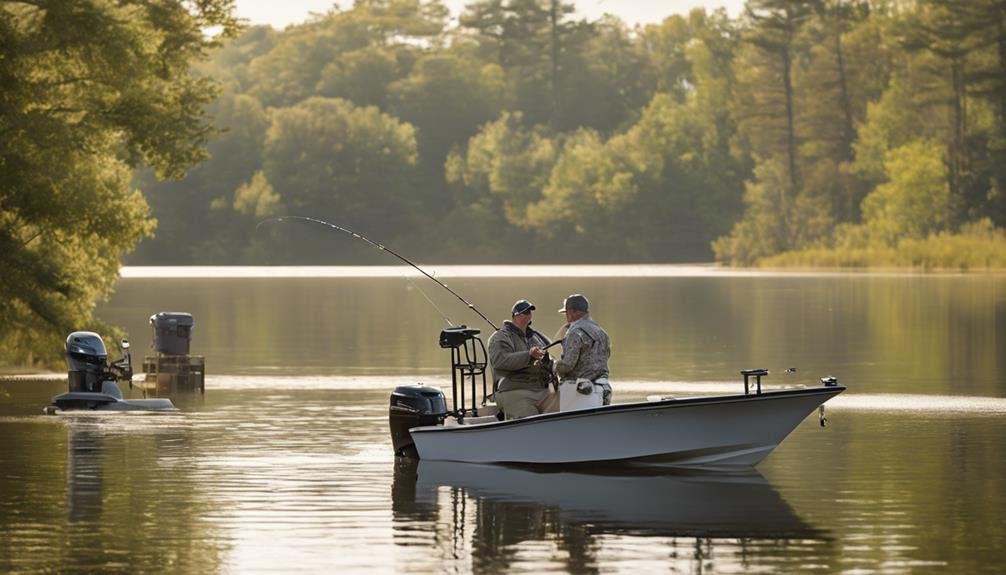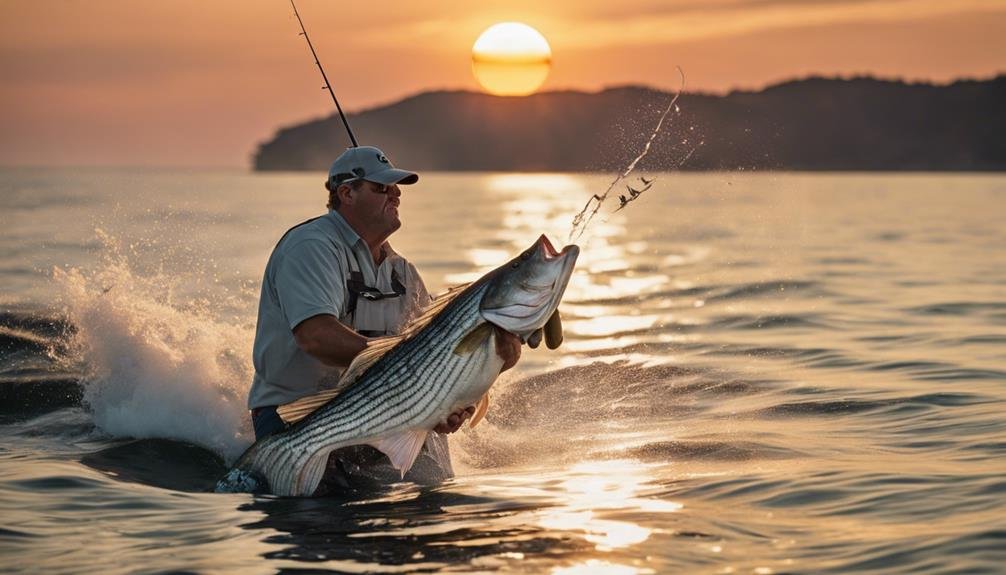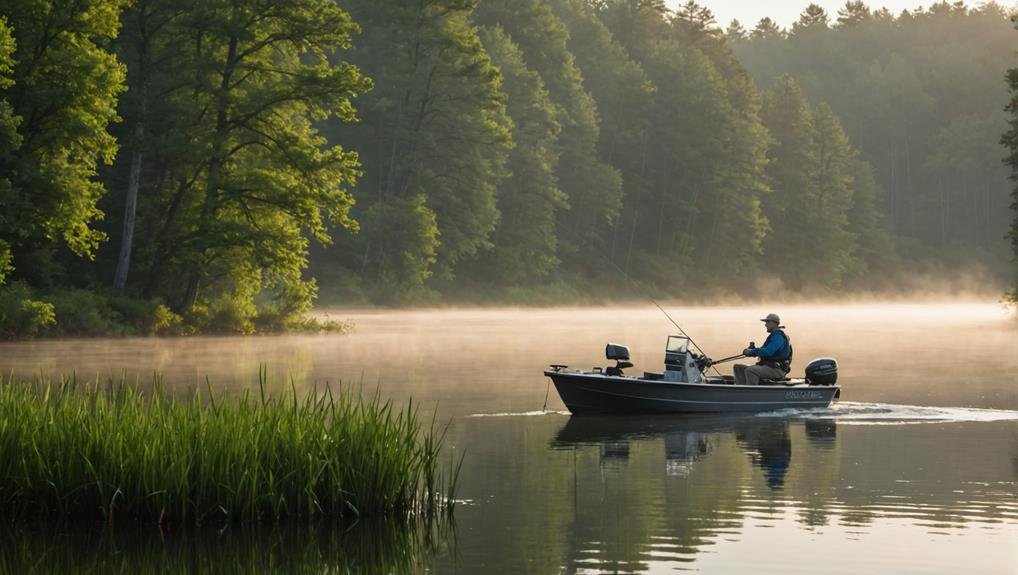When you consider Striper fishing at Lake Texoma, it offers a unique blend of challenges and rewards. This lake, known for its self-sustaining striper population, requires you to adapt your techniques as the seasons change. You’ll need to know specific regulations, such as bag limits and the proper licensing, to guarantee a sustainable environment. The thrill of catching a Striped Bass that can exceed 10 pounds is undeniable, but have you ever wondered what makes this lake ideal for the fish and the angler?
Key Takeaways
- Lake Texoma offers exceptional Striper fishing with peak season from March to May.
- Use topwater lures in spring and Fall and deepwater techniques in summer.
- Obtain proper fishing licenses for Texas and Oklahoma to fish on Lake Texoma.
- Anglers can harvest up to 10 Stripers per trip, ensuring sustainable fishing.
- Local guides provide equipment, bait, and expert fishing techniques.
Lake Texoma Striper Population

Lake Texoma boasts one of the most remarkable self-sustaining Striper populations in the United States, a feat achieved since the 1960s. This rare phenomenon is supported by the abundant shad bait in the lake, which fuels the feeding activity for Striped Bass to thrive. When you engage in Lake Texoma Striper Fishing, you tap into a rich history of successful fish management that only 11 other lakes in the country can claim.
Striped Bass in Lake Texoma are known for their size and numbers, with quality fish often exceeding 10 pounds. The ideal spawning conditions provided by the Red and Washita Rivers play a pivotal role in maintaining this self-sustaining population. Each year, these stripes can travel up to 80 miles upstream to find the perfect spawning environments, ensuring the continuation of their species.
As you cast your line, remember that Lake Texoma’s thriving Striper population directly results from these unique conditions and the lake’s natural bounty of shad. This combination makes Lake Texoma Striper Fishing a truly exceptional experience, offering novice and seasoned anglers the chance to reel in impressive catches.
Fishing Regulations and Seasons
When fishing for Striper on Lake Texoma, understanding the bag limits and seasonal techniques is essential.
You can harvest two stripes over 20 inches and eight under 20 inches per trip, with the peak season running from March to May.
Ensure you have the proper fishing license to enjoy these liberal harvest rates and varied fishing experiences.
Seasonal Fishing Techniques
Exploring the subtleties of seasonal fishing techniques for Striper on Lake Texoma demands knowledge and adaptability. During spring and Fall, Lake Texoma fishing is especially gratifying. Stripers frequently migrate to shallower areas as the water temperature rises as the water temperature rises, presenting a prime opportunity for utilizing topwater lures. The sudden splashes and aggressive strikes during a feeding frenzy make this method thrilling and efficient.
In the spring, concentrate on shallow coves where the water warms up more rapidly, attracting shad and Stripers. Similarly, in the falFallecreasing temperatures incite Stripers to pursue baitfish close to the surface, providing optimal conditions for topwater action.
During summer, Stripers move to deeper waters to stay cool. To reach them, you’ll need to adapt using weighted lures or live bait. Deepwater techniques are vital here, as the fish often linger around thermoclines, where water temperature remains more consistent.
Winter fishing demands patience and accuracy, with Stripers frequently located in the deepest sections of the lake. Slow-trolling with jigs or live bait yields the best results. Grasping these seasonal transitions ensures you can optimize your success and relish the varied fishing encounters Lake Texoma provides.
Bag Limits Overview
Understanding the nuances of seasonal fishing techniques is just one part of a successful Striper fishing expedition on Lake Texoma. Equally significant are the bag restrictions that dictate how many fish you can keep. On your fishing trips, you’re allowed to harvest 2 Striper over 20 inches and 8 under 20 inches per angler.
Bag limits guarantee sustainable fishing by controlling the harvest rate. For a group of 5 anglers, the collective limit increases to 10 Striper over 20 inches and 40 under 20 inches. These regulations are essential for maintaining the Striper population, especially during the peak season from March to May when fishing is at its best.
Here’s a handy table to summarize the bag restrictions for different group sizes:
| Group Size | Striper over 20 inches | Striper under 20 inches |
|---|---|---|
| 1 Angler | 2 | 8 |
| 5 Anglers | 10 | 40 |
| Group Max | 10 | 40 |
Lake Texoma’s liberal harvest rate offers plentiful opportunities, but follow these limits to preserve the fishery’s health. Adhering to these guidelines contributes to a balanced ecosystem while enjoying an exciting and rewarding fishing experience.
License Requirements Explained
Understanding the license requirements for Striper fishing on Lake Texoma is important for a hassle-free and lawful fishing adventure. Texas and Oklahoma fishing licenses are needed, so ensure you obtain them before heading out. Knowing the size and bag limits is vital to avoid penalties and contribute to sustainable fishing practices.
Here are the key points you need to remember:
- Individual Harvest Limits: You can keep 2 Striped Bass over 20 inches and 8 under 20 inches.
- Group Harvest Limits: If you’re fishing in a group of 5, you can collectively harvest 10 Striped Bass over 20 inches and 40 under 20 inches.
- Peak Season: The peak fishing season on Lake Texoma is from March to May, and it offers the best chances for a successful catch.
- Special Regulations: Lake Texoma has specific rules to protect the Striped Bass population. Always check for updates on these special regulations to ensure compliance.
Fishing techniques vary with the seasons, adding to the excitement and challenge. By following these guidelines, you help maintain the fishery’s health and guarantee that Striper fishing remains a rewarding experience for everyone.
Successful Spawning Environment

In Lake Texoma, Striper thrives due to the ideal conditions in the Red and Washita Rivers. The right water current is important; it keeps the eggs suspended and guarantees a successful spawn. March or April rainfall is vital, with good flood rains leading to particularly strong spawns, as seen in 2015 and 2016.
Ideal River Conditions
Striped Bass thrive in rivers that offer the ideal current and water temperature blend necessary for fishing success. These river conditions guarantee that Striped Bass can reproduce effectively and maintain healthy populations. The best water temperature and current create an environment where their eggs can develop properly.
To achieve successful spawning, consider the following key factors:
- Water Temperature: Striped Bass spawn in water temperatures between 60-68°F. This range optimizes that the eggs have the highest chance of survival and hatching.
- Current: A moderate current is essential to keep the eggs suspended and aerated. This prevents them from settling on the riverbed and potentially suffocating.
- Shad Population: Abundant threadfin and gizzard shad in the river provide a rich food source, supporting adult Stripers and their young.
- Rainfall: March and April rains can enhance spawning success by improving river conditions. Years with good flood rains, like 2015 and 2016, often see excellent spawns.
Lakes like Lake Texoma benefit from rivers like the Red and Washita, which offer these ideal conditions. Striped Bass can travel up to 80 miles upstream to find the perfect spawning spot, ensuring their species’ continuation of the Water Current.
When discussing the ideal river conditions for Striped Bass, it’s impossible to ignore the significant role of water flow. Water flow is vital for a successful Striped Bass spawn because their eggs need flow to stay suspended in the water column. Without it, the eggs would settle to the bottom and fail to develop properly, leading to unsuccessful spawning.
In their quest for suitable spawning environments, Striped Bass can travel up to 80 miles upstream in rivers like the Red and Washita Rivers. This journey is essential for finding the right conditions, particularly the required water flow. Lake Texoma is a prime location where strong flows contribute to successful natural reproduction. During the spawning season, the water flow ensures the eggs remain afloat and develop into healthy fish.
While some lakes don’t naturally meet these spawning requirements and rely on hatchery stocking to maintain their Striped Bass populations, lakes like Texoma benefit immensely from the natural process.
The importance of water flow can’t be overstated; it’s a key factor that enables Striped Bass to thrive and reproduce without human intervention, guaranteeing healthy and sustainable fish populations for anglers and ecosystems alike.
Seasonal Rainfall Impact
With the arrival of seasonal precipitation, particularly in March and April, Lake Texoma becomes an ideal environment for Striper spawning. This precipitation impact is essential for a successful Striper wn because it enhances water conditions crucial production. When good flood rains occur, like in 2015 and 2016, the Striper population in Lake Texoma experiences excellent spawning periods.
Striped Bass need water currents to guarantee their eggs remain suspended in the water column until they hatch. In Lake Texoma, the Red River and the Washita River provide these necessary conditions. The combination of precipitation and river currents creates a perfect natural reproduction environment for Stripers.
To summarize, here are the key points:
- Seasonal Precipitation: Precipitation in March and April boosts the Striper spawn in Lake Texoma.
- Flood Rains Impact: Good flood rains, like those in 2015 and 2016, lead to excellent Striper spawns.
- Current Requirement: Striper eggs must stay suspended in the water column, which requires a strong current.
- Ideal Rivers: The Red and Washita Rivers in Lake Texoma provide perfect spawning conditions.
Lake Texoma Features
Lake Texoma, with an impressive 89,000 surface acres, is renowned for its deep waters and intricate structures, which create a perfect environment for a thriving Striper population. The abundant threadfin and gizzard shad provide constant bait, ensuring the Striped Bass here remain well-fed and numerous. Fishing in Lake Texoma offers year-round opportunities, but the peak season from March to May is especially rewarding.
The Red and Washita Rivers are essential for Striper spawning, with the fish traveling up to 80 miles upstream to find the ideal conditions. These rivers contribute to the lake’s unique status as one of only 11 in the USA where Striper populations are self-sustaining. Understanding these features can greatly enhance your fishing experience.
Here’s a quick reference table to highlight key features:
| Feature | Importance | Seasonality |
|---|---|---|
| Deep Waters | Perfect Striper habitat | Year-round |
| Abundant Shad | Constant bait source | Year-round |
| Red & Washita Rivers | Best spawning conditions | Spring (March-May) |
Visiting Lake Texoma for Striper fishing is not just about catching fish but immersing yourself in a rich and dynamic ecosystem. Get ready for an unforgettable fishing adventure!
Fishing Resources and Services

[TEXT]:
Fishing at Lake Texoma is well-supported by various resources and services designed to enhance your experience. Whether a novice or a seasoned angler, Lake Texoma offers everything for successful striped bass fishing. To make the most of your trip, take advantage of the following:
- Local Guides: Experienced local guides are available to provide equipment, bait, tips, and techniques. They know the best fishing spots and are crucial for a safe, enjoyable fishing adventure.
- Licensing and Regulations: You’ll need both Texas and Oklahoma fishing licenses. Lake Texoma has specific size and bag limits for striper fishing, so following these regulations is vital.
- Conservation Efforts: Conservation initiatives are in place to protect the striped bass population and promote sustainable fishing practices. This guarantees that future generations can also enjoy the thrill of striper fishing at Lake Texoma.
- Fishing Spots: The lake is abundant with prime fishing spots, and local guides can help you find these hidden gems, improving your chances of landing a big catch.
Striped Bass Habitat and Behavior
Understanding the habitat and behavior of striped Bass is vital for a successful fishing trip. Stripers are anadromous, meaning they can thrive in bBassfreshwater and saltwater environments. Their habitat spans from the Mississippi River outlet to Nova Scotia, Canada, with each population exhibiting unique migratory patterns. During spawning seasons, they seek specific environments with the right current flow to lay their eggs.
Stripers prefer water temperatures ranging from 55 to 68 degrees Fahrenheit when most active. Depending on the season and their life stage, you’ll often find them in estuaries, coastal waters, and river systems. Knowing their migratory patterns will help you locate them more effectively.
Stripers’ feeding habits are equally diverse. They are opportunistic predators that feed on fish, crustaceans, mollusks, and worms. Their diet can vary depending on their size and location. Understanding these feeding behaviors is essential for selecting the right bait and lures.
Striped Bass Size and Records

When it comes to striped Bass, their size can be truly impressive and a major draw for anglers. You might be surprised that the largest recorded striped Bass weighed 125 pounds. While this is an outlier, it reflects the potential Bass these Bass can reach. For most anglers, landing a striped bass over 50 pounds is considered a prized achievement and a story worth telling.
On Bassage, striped bass range in size from 5 to 25 pounds. However, for those seeking trophy catches, you’ll want to target fish that exceed 40 pounds. These larger specimens are often the highlight of an angler’s career. The world record for a striped bass catch currently stands at an impressive 81.88 pounds, showcasing the incredible potential of these fish.
To summarize the key points about striped bass size and records:
- Largest Recorded Size: 125 pounds.
- World Record Catch: 81.88 pounds.
- Average Size Range: 5 to 25 pounds.
- Trophy Catch Threshold: Over 40 pounds.
Understanding the size and weight of striped Bass can enhance your fishing experience, pushing you to aim for those record-breaking trophy carcass.
Fishing Gear and Techniques
After grasping the impressive size potential of striped Bass, let’s explore how to gear up and employ effective techniques to catch these remarkable fish—Bass by selecting tackle suited to the size and habitat of the Bass you’re targeting. For trolling, specialized techniques like wire or lead-core liBasscan make a difference.
Chumming with live bait, such as menhaden, is a fantastic way to attract schools of stripers. Topwater lures like pencil poppers can be an exciting visual element to your fishing experience. Vertical jigging and drifting rigs are effective if you prefer to fish near the bottom. Swimming plugs and soft-plastic eel imitations offer versatile options for catching striped Bass in various conditions.
Trolling with bunker spoons or tube-and-worm rigs is another highly effective way to target striped Bass. This method works well in different water conditions and allows you to cover more ground.
When basing natural bait, opt for bassinette circle hooks to reduce mortality rates and comply with conservation regulations.
Conclusion
You’ve now got a solid grasp of what makes striper fishing on Lake Texoma so thrilling and sustainable. With the right gear, knowledge of seasonal techniques, and compliance with regulations, you’re all set to reel in some impressive catches. Remember, honoring the lake’s ecosystem guarantees future generations will also enjoy this fantastic fishing experience. So grab your license, pack your lures, and prepare for an unforgettable Lake Texoma adventure!
FAQs
What is striper fishing?
Striper fishing refers to catching striped Bass, a popular game fish known for its strength and size. Stripers are typically found in both frBassater and saltwater environments, including rivers, lakes, and coastal areas. Anglers target striped Bass because of their challenging fight and rewarding catcBassey Points:
- Striped Bass is targeted.
- Popular for their size, strength, and challenging class.
- It is found in lakes, rivers, and coastal waters.
What are the best techniques for striper fishing?
The best techniques for striper fishing include:
- TrollinBassvolves slowly dragging bait or lures behind a boat. It is effective in large bodies of water where stripers roam.
- Live Bait Fishing: Using live bait like eels, bunker, or shad is highly effective, especially in deeper waters where stripers are feeding.
- Casting with Lures: Artificial lures such as swimbaits, crankbaits, or topwater plugs work well, especially when stripers feed near the surface.
- Drift Fishing: This method involves drifting with live bait or jigs in tidal waters, and it is particularly effective for catching stripers in the current.
Top Techniques:
- Trolling in lakes or rivers.
- Live bait fishing with eels or shad.
- Casting with artificial lures.
- Drift fishing in tidal waters.
What is the best bait for striped Bass?
The best bait for striped Bass includes:
- Eels: A go-to bait for saltwater striper fishing, especially in colder months.
- BunkBassMenhaden): This oily baitfish attracts stripers in both live and cut form.
- Shad: Used live and as cut bait, shad are effective for catching stripers in Basshwater rivers and lakes.
- Clams and Mackerel: Ideal for surf fishing stripers, especially in the early morning or late evening.
Best Baits:
- Eels for saltwater.
- Bunker and shad in both freshwater and saltwater.
- Clams and mackerel for surf fishing.
Where are the best places to fish for striped Bass?
Striped Bass can be found in:
- Coastal Waters: Saltwater stripers are often found in bays, embassies, and coastal shorelines, particularly along the East Coast of the U.S.
- Rivers: Striped Bass migrate up rivers during spawning season, making riverbanks a basalt spor for basso.
- Lakes and Basseservoirs: Freshwater stripers are stocked in lakes and reservoirs, providing year-round fishing opportunities.
- Surf and Tidal Waters: Stripers often come to shore, making surf fishing from beaches and jetties highly effective.
Best Locations:
- Coastal waters and bays for saltwater fishing.
- Rivers during the spawning season.
- Lakes and reservoirs for freshwater stripers.
- Surf and tidal waters for shore fishing.
What is the best time of year for striper fishing?
The best time of year for striper fishing varies by region, but typically:
- Spring and Fall are prime seasons for striper fishing as the fish are more active and feed heavily during their migrations.
- Summer: Striper fishing can still be productive in deeper, cooler waters.
- Winter: In some regions, particularly saltwater, striper fishing can still be good, with live eels being a favored bait.
Best Seasons:
- Spring and Fall are peak activity.
- Summer in deeper waters.
- Winter in some smaller regions.

